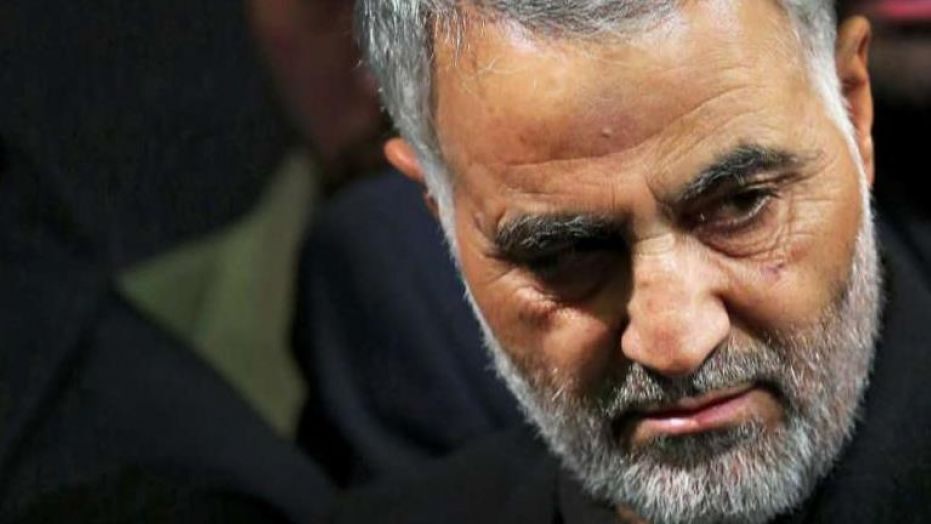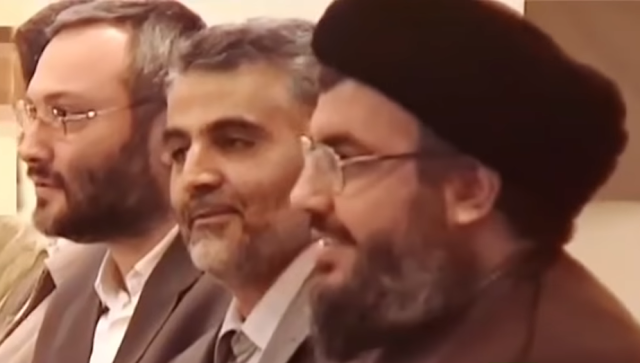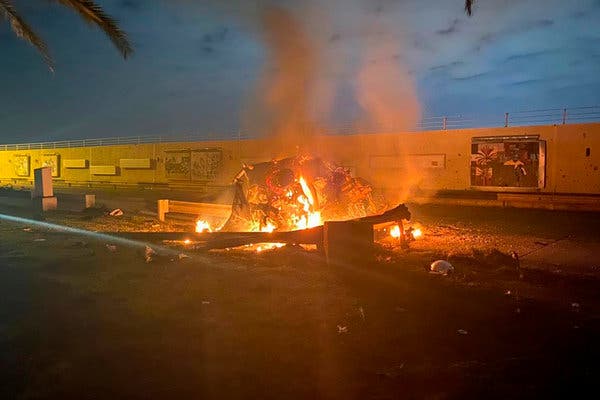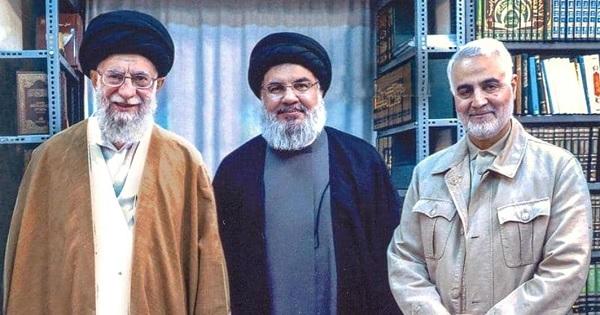Following Killing Of IRGC Qods Force Commander Soleimani, Lebanese, Syrian Press Reveal New Details About His Aid To The Assad Regime And Hezbollah, His Struggle Against The U.S., And The Arming Of Gaza Terrorist Organizations

Following the U.S. killing of IRGC Qods Force Commander Qassem Soleimani, Lebanese and Syrian media outlets, particularly the Hezbollah-affiliated Lebanese Al-Akhbar daily, published many reports providing new details about Soleimani’s activity and his support for Hezbollah, the Assad regime in Syria, the Palestinian factions in Gaza, and the Iran-backed Shi’ite resistance factions in Iraq. The articles explain how Soleimani managed and equipped fighters to confront the U.S. forces in Iraq; how he turned Syria into a center for coordination between the various resistance forces in Lebanon, Iraq, and Palestine, with the cooperation of Hezbollah military chief ‘Imad Mughniyeh; how he helped the Assad regime deal with the protests against it and persuaded Russian President Putin to intervene in Syria; and how he oversaw the arming of Gaza via many channels, and even on occasion mediated among the Palestinian factions.
The following are translated excerpts from these reports:
Soleimani Made Syria Into An Aid And Supply Base For The Resistance In Iraq, Lebanon, And Palestine
In a January 4, 2020 article in Al-Akhbar, writers Elie Hanna and Hussein Al-Amin described how in 1998 Soleimani had operated in Syria and made the country into an aid and supply base for conducting the fight against the Americans in Iraq and for supporting Hezbollah in Lebanon: “This [Soleimani-Syria] relationship began in 1998, two years before the liberation of South [Lebanon] in 2000, when Soleimani was appointed Qods Force commander. At that time, the commanders of [Iran’s] Islamic Revolutionary Guard Corps [IRGC], who wanted to monitor foreign affairs, particularly the relations with the resistance forces in Lebanon and Palestine, chose to live in Syria. Since then, Hajj Qassem [Soleimani] considered Syria a ‘safe’ base for assigning missions, holding meetings, and utilizing the resources and capabilities of the Syrian military, as well as [Soleimani’s close relationship with] Syrian President Bashar Al-Assad.

“Then came the American invasion of Iraq, in 2003, and it appeared that Syria would be next in line to be invaded by the U.S. At that time, a base was established [in Syria] for aiding the Iraqi resistance [by supplying it] with arms and equipment for it to fight the Americans, and Qassem Soleimani played a prominent role in this aid…
“The real turning point in the Soleimani-Syria relationship came after the July 2006 [Second Lebanon] war. His role in Syria grew by orders of magnitude, as a new stage began in the activity of his comrade and partner in Hezbollah, the martyr ‘Imad Mughniyeh. Two years later [in 2008], Mughniyeh, the partner in Soleimani’s projects in Syria, was martyred,[1] and therefore this entire burden fell on the shoulders of Soleimani alone.”[2]
Soleimani Helped Establish The National Defense Forces Militia To Protect The Assad Regime From The Rebels
Hanna and Al-Amin also revealed that Soleimani played a major role in drawing up a work plan to strengthen the Assad regime after the protests against him broke out in 2011: “Another turning point in the Soleimani-Syria relationship came in 2011. Soleimani foresaw the plot against Syria [i.e. the anti-Assad uprising] and after monitoring [the developments] for a short time decided to boost the role of the Iranian advisors in the country under the Iran-Syria agreements, and later drew up a work plan of principles based on the following: protecting President Assad and his status; protecting the unity of the Syrian Army as much as possible; protecting the capital Damascus following the fall of the other provinces; and preventing western Syria from being cut off from Damascus by protecting Homs. Later on, Hajj [Soleimani] began to collaborate with the Syrian leadership in building and developing a supporting army – the National Defense [Force]…”[3]

Soleimani Persuaded Putin To Intervene In Syria
Al-Akhbar also claimed that, after the fighting in Syria intensified in 2015, Soleimani contacted Russia and it was effectively he who persuaded President Putin to intervene in the country. Hanna and Al-Amin wrote: “In 2015, when the threat posed by ISIS increased and fighting broke out around Aleppo, Soleimani began to make efforts to arrange a Russian intervention in the Syria war. He left for Moscow following ‘high-level contacts between Russia and Iran that yielded an agreement for transferring additional aid to Assad,’ for ‘supplying more advanced Russian weapons to the Syrian army and for establishing a joint war room of the two allies [Iran and Russia], and Iraq.’”[4]
An article by Hussein ‘Aliq stated: “Soleimani was… the architect of the Damascus defense lines, and was Assad’s partner on the ground in the Syria battles, like the battle for Aleppo. It was he who persuaded Putin to intervene in Syria, and he was [also] the partner of the Turkish intelligence chief in the north Syria arrangements…” [5]
Soleimani Found Ways To Smuggle Weapons Into Gaza, Established Cyber And Information Units To Handle Palestinian Issues
Another Al-Akhbar reporter, ‘Abd Al-Rahman Nassar, wrote about Soleimani’s extensive military aid to the Palestinians in Gaza, the various sophisticated methods he developed for smuggling weapons there, and his occasional role in mediating between Palestinian factions. He wrote: “A commander in the [Palestinian] resistance says that nearly every missile and rifle in Palestine bears Soleimani’s fingerprints… He personally oversaw the establishment of the route for transferring game-changing missiles and weapons to the Gaza Strip. The route was roundabout: from the [Persian] Gulf to the Red Sea and through Eritrea to Sudan, where there were factories for assembling [the missiles], and then via Sinai to the resistance [in Gaza]. That was the initial route of the missiles, before it was decided that Gaza would manufacture its own weapons, of every kind. At certain points, when the situation in Sinai was difficult and the resistance needed weapons urgently, Hajj [Soleimani] took a gamble [and came up] with the idea of throwing the weapons from ships passing through the Suez canal, in barrels, after verifying the direction of the sea currents [and making sure] that they will reach Gaza. The resistance [fighters] would sail out a short distance into the sea and collect most of the barrels…

“There is no prominent Palestinian leader, political or military, who did not meet with Soleimani… He even mediated in several disputes between the factions, in various periods. He ate with them and met with them in Iran, Syria, Lebanon and other countries… and established units with many missions related to Palestine, including in the fields of cyber and psychological warfare, and the like… When Hamas decided to change its political charter, it sent Soleimani a copy so he could review it and make recommendations before the [Hamas] political bureau approved it…

“Soleimani received special dispensations for the Palestinian resistance from the Syrian regime… He obtained Assad’s permission to conduct missile tests in the Syrian desert, and permission to land planes on a special landing strip in one of the Syrian air bases, without the Syrian soldiers questioning the identity of those coming and going. There were many other favors as well…
“Even during the worst periods of tension between Hamas and Iran, Soleimani did not end his contact with the movement, especially with its military wing, but continued to supply it with weapons, without any delay…
“In the recent weeks, Soleimani met with many political and military Palestinian leaders, to examine in minute detail their needs in light of the growing economic pressure on the resistance axis and to assess the outcomes of the latest confrontations with Israel. In 2017, after Trump declared Jerusalem the capital of Israel, Soleimani called the headquarters of [Hamas’s military wing], the Al-Qassam [Brigades], and of Saraya Al-Quds, the military wing of the [Palestinian] Islamic Jihad in Gaza, and spoke with them directly and warmly, promising to continue his ‘open-ended assistance’ to the resistance factions…”[6]
Israel Passed Up Opportunities To Assassinate Soleimani
Al-Akhbar reporter Hadi Ahmad wrote that Israel had two opportunities to assassinate Soleimani, but passed them up. One was on February 12, 2008, the day of ‘Imad Mughniyeh’s assassination: “When ‘Imad Mughniyeh disembarked from his vehicle in the vicinity of the village of Susa [in Damascus], the [Mossad] operatives noticed another man by his side. It was none other than Qods Force commander Qassem Soleimani. The two stood there talking for a while, and then entered a building for a meeting with Palestinian officials. At that moment, the Mossad [operatives] had a one-time opportunity to kill them both, but at the time the equations caused them to refrain from targeting Soleimani. They waited for Mughniyeh to exit the building alone… and then Zero hour arrived, and they pressed the detonator. Almost five years later, Israeli and American intelligence chiefs expressed regret for missing that opportunity…
“That was not Soleimani’s first brush with death, nor was it his last… Being one step away from the enemy was routine for him. In 2004, while touring Lebanon and visiting the Israeli border with ‘Imad Mughniyeh and other commanders, near the Al-Manara [border crossing]… two Israeli tanks suddenly appeared before them, and Israeli soldiers disembarked and aimed their weapons at them, but not one of [the commanders] moved. On the contrary, they aimed their own weapons at the [Israeli] soldiers. After several moments of silence in which none of them fired, the Israeli soldiers turned tail and resumed their patrol, while Soleimani and the others stood their ground…”[7]

Soleimani Conferred With Syrian Clans On Attacking U.S. Forces
A report by the Syrian Observatory for Human Rights stated that “on December 26, 2019, a delegation of [Syrian] Arab clans met with… Soleimani with the aim of uniting forces against the U.S. troops… [The meeting] with these figures was held at the official invitation of Iran, [and included] Faisal Al-‘Azil, a dignitary of the Al-Ma’amara clan; Khatib Al-Talib, representative of the Al-Bu ‘Asi clan and commander of the National Defense [Forces] headquarters in Al-Qamishli; the sheikh the Al-Sharayin clan, Nawaf Al-Bashar, and the sheikh of the Harb clan, Mahmoud Mansour Al-‘Akoub. The meeting dealt with attacking the American forces and the Syria Democratic Forces.”[8]
[1] See MEMRI Special Dispatch No. 2302, Lebanese Daily Reveals New Facts about ‘Imad Mughniyah’s Career in Hezbollah, April 1, 2009.
[2] Al-Akhbar (Lebanon), January 4, 2020.
[3] Al-Akhbar (Lebanon), January 4, 2020.
[4] Al-Akhbar (Lebanon), January 4, 2020.
[5] Al-Akhbar (Lebanon), January 3, 2020.
[6] Al-Akhbar (Lebanon), January 4, 2020.
[7] Al-Akhbar (Lebanon), January 4, 2020.
[8] Syriahr.com, January 3, 2020.
(MEMRI )
Leave a Reply
You must be logged in to post a comment.